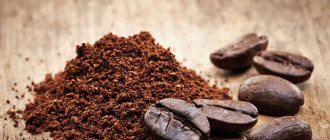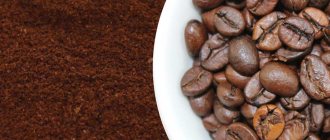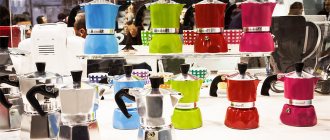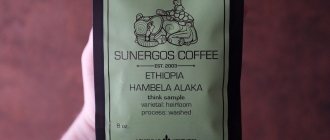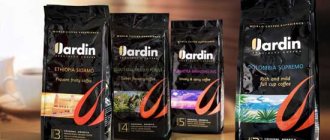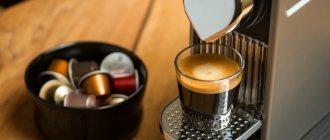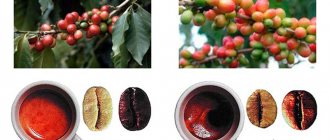Before grown, roasted coffee beans combine with water, become the basis of a magical drink and give us the incomparable joy of coffee drinking, they must be ground, i.e. crushed to a powdery free-flowing product. When buying granulated sugar in a store, we are not particularly interested in the size of the grains of sand; the product will be sweet in any case. But if you need coffee, the degree of grinding of the beans interests connoisseurs no less than its variety. The shades of coffee taste depend on it. A mistake in choice can be fatal and ruin even an expensive exclusive product. This cannot be allowed, so let’s dwell on this important topic.
Types of coffee grinding
First, let’s talk about what the degree of grinding of beans affects. The taste and aroma of the drink depend on the size of the fractions. If you use a grind that is not suitable for the coffee machine, the coffee will turn out “empty”. Read more about the differences in the article “Types of coffee grinding and what it affects.”
There are 5 grinding levels:
Powder - used exclusively for Turks. The coffee is brewed on the stove for a few minutes, so the factions have time to fully develop their aroma. The drink turns out thick and very strong.
For espresso – suitable for coffee machines in which the drink is prepared by steam passing through ground coffee beans.
Small (thin) – also suitable for Turks.
Medium is the most common. It is most often used when brewing a drink in a coffee machine.
Large (coarse) – fraction size up to 1 mm. The particles are retained in the filter, so the deep notes of the drink can be revealed. Suitable for French press and drip coffee maker.
Cooking using coffee grinder millstones
The coffee grind is of high quality because the beans are not chopped, but ground.
Residents used such manual coffee grinders in the Middle Ages. Their appearance has remained the same since then. You can purchase:
- a European coffee grinder, similar to a mill;
- Turkish cylindrical, with a rotating handle.
Such devices produce a very high-quality product, although grinding takes from 1 to 5 minutes. Devices without dispensers. Therefore, first the grains are weighed. The screw adjusts the distance between the millstones of the elements.
There will be no foreign smell if you grind on stone or ceramic millstones.
Grinding devices
Manual coffee grinder
Coffee grinders are manual and automatic. The difference between the two is that the manual device is activated by a handle. It is rotated clockwise and the millstones are activated.
The advantage of such coffee grinders is their low cost and autonomous operation. You don't have to look for an outlet or buy batteries.
The disadvantage is that you cannot choose the degree of grinding and obtain powder fractions. Only a medium grind is obtained.
It will not be possible to achieve perfectly ground beans. Some of them will not be completely crushed.
Another disadvantage is that you will have to make an effort to manually grind a large number of grains.
Interesting! Cappuccino with chocolate chips in bags
Electrical device
This coffee grinder is often equipped with an additional function - you can select the degree of grinding using the switch lever.
Also among the advantages is that the unit works independently and ideally grinds grains.
The downside is that it works on the network and the high price.
The most common types of coffee
The taste of the drink largely depends not only on the grinding of the beans, but also on the variety. The most common types are Arabica or Robusta. The Arabica variety is grown in Ethiopia. Kilometers of tree plantations provide employment to thousands of people. The climate of Ethiopia is ideal for growing plants of this level; it is here that the temperature is not very high and the air humidity is quite high, which is acceptable for the favorable growth of plants. Proper care of plants brings a huge harvest. Arabica beans have a muted sour taste and contain slightly less caffeine. Among the Arabica varieties that stand out to buyers are Mocha, Typica, Aramosa, Barbon and Catura. Robusta coffee also has its admirers, although Arabica coffee is in the lead. Trees of this variety are characterized by high productivity; another advantage is that, unlike Arabica, they are not whimsical in all climatic conditions. This type of plant is also resistant to diseases. The only drawback of this plant is that the fruits take about a year to ripen. Everyone's taste preferences are very different: some like notes of piquancy in the drink, some like weak shades of caffeine, others remain devoted to the classic aroma and taste. The main thing is to decide on your preferences and choose a specific technology for grinding and preparing the drink.
How to grind coffee without a coffee grinder
You can grind the grains using a blender or food processor. Measure out the required amount of raw material and pour it into the unit. Cover with a lid and turn on medium speed. The process will take about 30 seconds.
An immersion blender will do. Place the beans in a narrow, high-sided container and insert the blender. After 30-40 minutes, the grains will be crushed to medium-sized fractions.
A rolling pin works well. Place the beans on a board, cover with a bag and grind with a rolling pin until the desired degree of grinding is achieved.
Also suitable:
- hammer;
- knife;
- mechanical meat grinder;
- a blunt, heavy object.
For instructions on the above methods, see the article “How to Grind Coffee Without a Coffee Grinder.”
By degree of roasting
Different countries have historically used different temperatures for roasting grains.
This type includes Scandinavian (200 – 210?) and South American (210 – 220?), which are characterized by a careful attitude towards coffee beans. The drink made from such grains is very sour, but you can really capture all the aspects of single-origin varieties: chocolate, spicy, nutty overtones. But in Russia this category is not widespread enough specifically because of acid.
It is also called Vienna (225 – 230?). This is a commonly found roast level. It is mostly used to make espresso blends. Gives the best combination of richness of taste, aroma and bitterness. It is recommended to start getting acquainted with the world of coffee with recipes like these.
In another way - French (240?), Italian (245?) and Spanish (250?). There is no sourness in the drink, only bitterness with caramel notes is felt. It is very important that the coffee is freshly roasted. You can tell by its appearance: a good grain will be oily and shiny.
Built-in coffee grinder
Advantages and disadvantages
The optimal solution is a coffee machine with a built-in coffee grinder. This feature increases the cost of the unit by 20%. But you can get perfectly crushed grains with the press of one button.
In a semi-automatic unit, we set the required grinding ourselves. With an automatic device, no adjustment is required.
The only drawback is that it is impossible to remove the coffee grinder reservoir and wash it. You will have to run a complete cleaning of the coffee machine.
Units of the De'Longhi (Delonghi), Merol, Bosch, Saeco brands are common. These manufacturers produce models for home use and professional coffee machines.
How do the models differ?
Now about the difference between devices of three price categories.
The cost of a budget coffee machine with a built-in coffee grinder starts from 55 thousand rubles. It is equipped with metal millstones. The power is sufficient for preparing an invigorating drink at home.
In such devices you will have to independently set the degree of grinding. Typically there are models with two grinding options - coarse and fine.
Units from 80 to 100 thousand rubles come with metal and ceramic millstones. The degree of grinding is also selected manually. But there is more choice of cars in this category.
Devices costing more than 100 thousand rubles include a coffee grinder with ceramic millstones. They are quieter than metal ones and do not overheat during operation.
What are rotary devices?
They contain knives for crushing grains. But the coffee does not grind evenly. And therefore, even the most expensive coffee will not provide its subtle flavor nuances.
The grains also overheat in them. To obtain uniformity of the powder, the coffee grinder works for a long time, with periodic shaking, which then affects the taste. Drinks will have a burnt smell.
To ensure uniformity of the powder structure, it can be sifted.
Especially if you use a mixture of Arabica and Robusta. Because in robusta the grains are hard, and you will not achieve uniformity without sifting.
To prevent the particles from overheating, make several passes. Grind a little, turn off the coffee grinder, let it cool, then again, etc.:
- Fine grinding requires turning on the device for 4 to 5 seconds and repeating the procedure 15 to 20 times.
- Moderate grinding - 2 to 3 seconds and 10 to 12 times.
- Rough - from 3 seconds and from 6 to 8 times.
Be sure to stir the contents with a spoon after turning off.
Selecting the grinding degree
Consider the type of coffee machine
Choose a grind depending on your coffee machine. The manufacturer provides information in the instructions.
Interesting! What is mocha coffee and how to make it?
Manufacturers of professional coffee machines recommend using coffee of the same brand.
Brew a test cup. If the drink is watery or very bitter, the degree of grinding is not suitable.
Special espresso blends are produced. They are suitable for all models of coffee makers and are already ground.
The coffee machine cannot be used to brew coffee from ground flavored beans. They contain a large amount of oils that will damage the unit. The article “Which coffee beans is best to choose for a coffee machine” is described in detail.
Grinding degree
In semi-automatic units, the drink is brewed from medium-ground beans. Fine fractions are not used in all brands. They are suitable for models in which steam under pressure passes through the ground grains.
Powdered coffee grinding is not suitable for a coffee machine. Small particles will clog the filter. At best, the drink will cook slowly. At worst, the device will fail.
Large particles will not have time to impart aromatic and taste properties to the water. The drink will be watery.
Automatic devices independently set the degree of grinding depending on the type of drink, temperature and pressure.
The choice of grinding degree depends on the microclimate. Consider humidity and temperature.
If the humidity is above 85%, the coffee beans become slightly larger. The crushed particles become compacted, and the coffee acquires a bitter taste.
At warm temperatures and average humidity, the grains may not have time to impart their flavor to the water. Therefore, they are first compacted in a holder.
Tassimo wheels
Capsule-type coffee machines brew coffee from T-discs.
Place the capsule in the coffee machine compartment (location depends on the model) and turn on the device.
The device reads the barcode from the disk and sets the parameters for making cappuccino or latte. The needle will then pierce the capsule and a stream of water will flow through the pressed coffee.
The advantage is that there is no need to select the degree of grinding.
Information about the existence of reusable T-disks is erroneous. Such a product is not produced today.
Unscrupulous companies sell supposedly reusable capsules. But they will only ruin the coffee machine.
How to adjust the grind
Depending on the model of the device, the degree of grinding can be set with a button on the panel or with a dial-regulator.
The numbers on the regulator are: 1 – fine grinding, 3 – medium, 5 – coarse. The number of digits depends on the model.
The smaller the distance between the millstones, the larger the fractions will be. The first time you try, you may not be able to adjust the desired degree of coffee grinding. Experiment and brew a few cups.
Interesting! Mochaccino coffee: what is it?
The size of the fractions affects the taste of coffee. Coarse grinding produces a drink with a sour taste. From small - with bitterness.
Coffee extraction takes no more than 25 seconds. If less, the grind is too coarse. More - small.
In a unit with a coffee grinder, the beans are crushed to large fractions in about 9 seconds. It takes 15 seconds to get a medium grind. Small – 20 seconds.
Ground coffee beans for espresso
Espresso grinding in coffee machines is fine. It differs from the usual thin one, but is larger when compared to the ultra-thin one. This is a special grind.
Therefore, very fine grinding of coffee to brew a drink is not suitable.
Important! It will turn out bitter and burnt, and the filter will also be damaged by the car.
The barista's recommendations are:
- To coarse grinding of coffee beans, when the thermometer shows low temperature, high humidity, along with atmospheric pressure.
- If everything is the other way around, then you need to pay attention to the finest crushing.
Because with a situation of high humidity, it will cause swelling and sticking of particles. Tannin is released ahead of schedule, and pre-wetting is reduced. And it all comes down to getting a bitter drink. When it is hot, the grains cannot retain natural moisture, and pre-wetting increases. And if the grains are coarsely ground, the drinks will be slightly sour.
There are no standard fine grinds. Everything is selected by trial and error. The only thing is that it will take about 25 seconds to get 25 ml of espresso with an error of 3 seconds. Place an electronic scale and a stopwatch in the kitchen and take action. Place the cup where you will pour the coffee on the scale.
- If the coffee flows out slowly (28 seconds have passed, but 25 ml of coffee has not been collected, and it comes out in a thin or intermittent stream), then you have made a mistake with the grinding. It turned out to be very small.
- Receiving your drink faster than 22 seconds will result in weak coffee. It's the coarse grind you're dealing with. In such cases, adjust the grinder to make the coffee particles smaller.
Preparing coffee beans for grinding
Before grinding, the grains are dried and roasted. Unroasted green beans are not used to prepare the drink. Read more in the article “How to roast coffee beans at home.”
It is better to grind the beans directly after roasting and immediately brew coffee from them.
Undried grains are dried in the oven over low heat. Wet beans will not produce a perfect grind.
The more time passes after heat treatment, the less tasty and aromatic the drink turns out. Ground grains lose their aromatic notes after 2-3 hours when stored open.
Place the ground coffee in a dark jar with a lid and use within 14 days.
Grinding Features
It's even better to grind the beans before making them. But how to do that? Let's talk a little about choosing a coffee grinder:
- A household coffee grinder with knives is not an ideal option. They are cheap, sold in all home improvement stores, and many people buy them expecting that they will end up with a wonderful drink. But this device grinds unevenly, resulting in large particles, dust, and medium ones, and the knives quickly heat up and burn out the granules. Not suitable for specialty coffee or just expensive types.
- A manual coffee grinder is great, but it takes time. You can quickly grind a portion for one or two cups, but for a group it will be even longer and more difficult, your hands quickly get tired. The advantages are that it is quiet, does not burn the grain, guarantees uniform grinding - the distance between the millstones can be adjusted.
- Professional coffee grinder with burrs - just great. True, it is not always wise to take one specifically for your home, because they are a little expensive and also make a lot of noise. But you can precisely set the appropriate grinding fineness for a coffee maker or coffee machine of any type.
For one or two servings, you can purchase a manual coffee grinder, or ask to grind it where you buy bean coffee, telling the merchant how you will prepare the drink.
Other grinding methods
Maybe these ideas will be useful for you. In any case, users on the network note that it works. The beans are not that strong, so they can be crushed or crushed, seemingly grinding at a suitable fineness - for a geyser, espresso machine, Turkish coffee, cups.
- Grind with a blender - it will turn out a little coarse and uneven, but it will do for the last case. Do not overheat, make a series of mini-presses rather than holding the button. Can be cooked in a French press.
- Grind it in a mortar and pestle - with due diligence, it will even turn out very fine for a cezve or espresso machine.
- Crush with a rolling pin or other similar hard object - just don’t use bottles, they are not very strong. You can put it in a ziplock bag and roll it out and crush it. In general, it will be a bit big.
- Break it with a hammer - also in a zip bag, as it will turn out quite small.
If it turns out very unevenly, you can try dispersing it through a strainer into different fractions, or continue grinding, and later boil it all in a cup with boiling water.
- Coffee grinding differs for different brewing methods.
- The longer the extraction process takes, the larger the granules should be.
- If the taste is inexpressive and sour, increase the degree of grinding; if it is very bitter and sharp, the granules are too small, try larger ones.
- It is better to grind in a manual coffee grinder or professional automatic machine, adjusting the millstones to the appropriate size; an electric coffee grinder grinds unevenly.
- If you grind the grains before production, the flavor and aroma properties will be the highest.
Grind coffee. What you need to know about grinding?
How do I grind my coffee? What equipment do I need? What are the grind levels? It looks like a kind of hell for a newcomer, and a field for fascinating stories from a coffee lover. You need to start from the question: what kind of coffee do you prefer to drink and what do you use to brew it? Yes, you may have to replace your old burr coffee grinder, which was a gift for your marriage. Without proper grinding, you most likely will not get a good drink.
And in truth, most coffee lovers really don’t know that the grind for a French press is different from the grind for Turkish and espresso!
What does grind size affect?
The grind size first determines the surface area of the coffee that will interact with water during brewing. In the coffee world, the process of extracting flavor components, oils, and aroma from coffee during brewing is called extraction. So, if the grind is very small, then “overextraction” will occur - the coffee will taste bitter. With a very large grind, “underextraction” will occur, and as a result - liquid and sour coffee in the worst sense of the word. In both options, you will not get any unique bouquet of taste, and most likely you will not like the coffee.
There is a special systematization of grinding degrees, which is quite common and understandable even for ordinary drink lovers who do not have the knowledge of coffee industry experts. For now, we'll tell you everything.
1. The smallest grind (flour, almost to dust). Under the Turk.
2. Fine grind (sweet powder). For espresso machines.
3. Medium grind (finely ground salt). Excellent for a geyser coffee maker (moka).
4. Medium grind (a little finer than for Chemex). Hario V60 and Aeropress.
5. Medium grind (coarsely ground salt). Chemex and siphon.
6. Coarse grinding (bread crumbs). French press.
A small graphic will help you understand clearly:
Equipment for grinding coffee?
You can grind coffee using several available devices or machines. For this purpose, manual and electronic coffee grinders are used.
Manual coffee grinders.
The manual option will usually achieve a medium grind, but it will most likely be uneven. In addition, such a device must always sharpen the blades manually, and also put in a lot of time and effort to get the desired powder from the grains. There are very high quality and unique manual coffee grinders with adjustable grind settings, such as the Orphan Espresso LIDO, starting at $175, while the most common coffee grinders can be found starting at $35.
Electronic coffee grinders.
There is a huge variety of different coffee grinders, but the first thing you need to find is your budget. Have you just started to become interested in coffee and don’t yet have an espresso machine, an AeroPress, or a French press? Do you drink coffee every day in a cafe and never drink it at home, or do you prepare a cup for yourself every morning?
The coffee grinder is the main element of the coffee making process, so it will most likely cost you half of your coffee budget, or even be the most expensive purchase. Expect that you will have to spend from $40 to $500 for a good-quality coffee grinder, depending on your wishes and interests.
The degree of grinding is a very important feature, the selection of which is recommended to be taken very carefully. Only an inattentive viewer may think that this is an insignificant detail, but specifically adjusting the grinding can lead to a result, the beauty of which is usually described in books, a fragrant drink with a rich taste and other attractive qualities. Try and experiment!
How to choose the right coffee for your coffee machine.
Greetings, honored guests!
To enjoy delicious coffee every day, it is not enough to purchase a coffee machine or coffee maker to make it. The question arises - how to choose coffee for them. After all, the quality of the drink depends specifically on the parameters of the grain. In addition, incorrectly selected raw materials can lead to equipment failure.
But what a wonderful world is revealed to those who have managed to sense and realize the beauty of the coffee drink! The abundance of flavoring and aromatic flowers is amazing. Let's figure out what kind of coffee there is for a coffee machine and coffee maker.
